Abstract
Soil aggregate stability and carbon–nitrogen content are critical indicators for assessing the vegetation restoration effects. Salix cupularis plays a vital role in rehabilitating desertified alpine meadows on the eastern Qinghai–Tibet Plateau. However, research remains limited about how afforestation influences the soil aggregate stability and associated carbon and nitrogen dynamics. In this study, sandy land (0 years) served as the control, and the spatial time replacement method was used to examine changes in the soil water-stable aggregate composition, stability, organic carbon (OC) and total nitrogen (TN) contents, and density at a 0–60 cm depth after 5 and 10 years of afforestation restoration (Salix cupularis). Ecological restoration significantly enhanced the proportion of macroaggregates (>0.25 mm) in the topsoil (0–20 cm), and improved aggregate stability. After 10 years of restoration, macroaggregates increased by 45.04% and 51.32%, respectively. The average weight diameter and geometric mean diameter of the aggregates increased by 51.32% and 59.53%, respectively. Following restoration, there was a gradual increase in the OC and TN contents in the soil, with the highest increase observed in the 0–10 cm layer (266.67% and 391.67%). The OC and TN of the aggregates also displayed a similar trend. Correlation analysis results indicated a significant positive relationship between the soil OC and TN contents and density, OC content in aggregates of various diameters, and the stability of these aggregates. The Pearson’s correlation coefficient for OC in aggregates > 1 mm was the highest. Compared with 5 years, 10 years of recovery were more conducive to the formation of macroaggregates, enhancement in aggregate stability, and the accumulation of OC and TN. Therefore, vegetation restoration on the Zoige Plateau can significantly enhance the soil water-stable aggregate composition and stability and can also increase the soil and OC and TN contents and density, thereby enhancing the soil ecological quality. This study provides fundamental data and theoretical support for rehabilitating desertified grasslands on the eastern Qinghai–Tibet Plateau.
1. Introduction
Soil structure is a complex dynamic system consisting of various combinations of soil aggregates and pores [1]. The agglomeration of primary soil particles (sand, silt, and clay) results in aggregate formation, with subsequent clustering of these aggregates creating larger-scale soil structural units [2]. The process by which soil aggregates are formed is influenced by several critical factors including cohesion, the bonding of inorganic substances, cementation of organic materials, and the development of organic–mineral complexes [3]. Tisdall and Oades suggested that different binding agents (polysaccharides, roots, fungal hyphae, and polymers) form aggregates of varying stability [4]. The transformation of soil aggregates involves biological (e.g., soil fauna, microbial activity, plant roots), physical (e.g., freeze–thaw cycles, fire events, rainfall erosivity), and chemical (e.g., oxides, calcium) processes [5]. In general, environmental changes substantially alter the soil structure [6]. Therefore, studying the soil aggregate stability is crucial for preserving soil health through agricultural practices and cycling terrestrial materials.
Soil organic carbon (OC) and nitrogen (N) are key components of the cycling of soil nutrients. OC is vital for the soil’s capacity to deliver various ecosystem services including C sequestration [7], maintain soil structure [8], and support microbial activity [9]. Since atmospheric N is unattainable for most organisms, the process of N fixation becomes crucial for sustaining life. Within the N cycle, biological N fixation is a critical contributor of N to soils, benefiting agricultural output [10]. Soil aggregates, the fundamental components of soil structure, act as reservoirs for OC and N [11]. Outcomes can differ significantly based on the specific region studied. For instance, OC is mainly found in macroaggregates [12] and sequestered in microaggregates [13]. An increase in N typically boosts the storage of soil OC, which enhances productivity by improving water retention in the soil and supporting soil fertility [14]. Furthermore, soil fertility is intricately linked to aggregate stability, which directly influences crop productivity through factors such as soil moisture, aeration, and temperature [2]. Consequently, understanding the composition and stability of soil aggregates of various particle sizes, along with their OC and N contents, is essential for assessing the soil environmental quality.
Desertification is one of the world’s most pressing social, economic, and environmental issues [15]. It causes a loss in soil nutrients and a decline in land productivity, which severely limits the growth of the regional ecology and social economy [15]. Vegetation restoration is an effective measure of ecological environment construction. Previous studies have shown that after vegetation restoration, the input of plant and animal residues, plant litter, and root exudates can increase the soil nutrient content and microbial and enzyme activities [11]. Additionally, with increasing years of vegetation restoration, the soil bulk density decreases, and soil aggregates become more stable [16]. In recent years, research on soil aggregates has predominantly concentrated on areas of ecological science including soil improvement [17] and microorganisms [18]. Nevertheless, the study of soil C and N remains a significant theme.
Northwest Sichuan’s alpine grassland is situated in a semi-humid region on the eastern edge of the Qinghai–Tibet Plateau. This area serves as a crucial water conservation zone and is an essential barrier to ecological security in China [19]. The ecological environment here is highly fragile, primarily due to the sandy and silty nature of the soil parent material, which lacks natural cohesion among the soil particles. Furthermore, in recent years, due to the long-term influence of natural and human factors, grassland desertification in this area has been severe [20]. At present, the focus and hotspots of desertification control work are mainly concentrated in the arid and semi-arid areas of Northern China. In contrast, relatively less attention and research have been paid to grassland desertification in alpine and semi-humid areas. Large-scale planting of the shrub Salix cupularis, a dioecious indigenous shrub of the Salicaceae family, has become a feasible strategy for ecological restoration on the eastern margin of the Qinghai–Tibet Plateau [21]. Current research on Salix cupularis plantations in this region has predominantly addressed plant population structure, the physical and chemical properties of soil, and the microbial community structure [22,23,24]. For instance, these plantations significantly increase the OC and N contents in the soil around the root system and facilitate moisture conservation in desertified soils, with soil moisture under the canopy increasing by 39%–93% compared with bare land [21]. Another study demonstrated a 50% increase in extracellular enzyme activity related to OC cycling and a corresponding rise in microbial biomass [25]. Conversely, relatively less attention has been directed toward soil aggregate stability or OC and N dynamics.
Therefore, in this study, Salix cupularis plantations with various restoration durations were selected to analyze the composition characteristics of soil aggregates and investigate the variation patterns in the soil aggregate structure as well as OC and TN during the restoration of alpine desertified grasslands. The objectives of this study were as follows: (1) Study the dynamic changes of soil aggregates and their stability; (2) explore the changing characteristics of organic carbon and total nitrogen contents in soil aggregates; (3) analyze the relationship between soil aggregates and soil physical and chemical properties. This study can provide scientific support for soil improvement and ecological rehabilitation in alpine desertified grasslands on the eastern margin of the Qinghai–Tibet Plateau.
2. Materials and Methods
2.1. Study Region
The research was conducted in Wache Township (31°51′–33°19′ N, 101°51′–103°23′ E), which is situated within Hongyuan County of Sichuan Province’s Aba Tibetan and Qiang Autonomous Prefecture (Figure 1). The terrain slopes from southeast to northwest, with an average elevation of over 3400 m. The climate belongs to the continental plateau cold temperate monsoon climate, with a short spring and autumn, long winter, and no summer. The average annual rainfall is 791.95 mm, with approximately 60%–75% occurring from May to September. The average annual temperature is 1.1 °C, with the coldest and warmest monthly averages of −10.3 °C and 10.9 °C, respectively. The average annual sunshine duration is 2158.7 h, and the annual total solar radiation is 6194 MJ m−2. The soil is classified as a Cambic Arenosol, which is sandy in texture, loose in structure, and low in nutrients [25]. Due to the long-term impact of human factors such as population increase and overgrazing as well as the impact of natural factors such as global warming and damage by rats and insects, the alpine grassland in northwest Sichuan has been severely degraded, and desertification has occurred in some areas. Since the 1980s, the main methods of restoring sandy grassland in this area have been voluntary tree-planting activities, the installation of sand barriers, and the planting of Salix cupularis. Salix cupularis is generally planted in May when the rainy season comes, with an interval of 1–2 m. After plants were successfully established, the sandy land was left alone to restore naturally, without human management or disturbance [22,23,24].
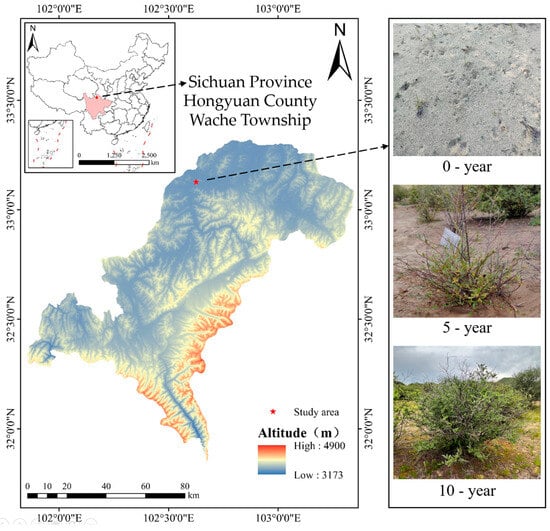
Figure 1.
Location of the study area and images of Salix cupularis at different ages.
2.2. Soil Sampling
In early June 2022, Salix cupularis shrublands restored for 5 years and 10 years were selected within the northwest Sichuan alpine sandy land ecological management demonstration area base. Untreated natural sandy land (0 years) served as the control sample for comparative analysis. In the above three types of areas, four 25 m × 25 m plots were selected as replicates. Then, three 1 m × 1 m quadrats were randomly selected from each plot for further sampling. First, the main habitat conditions were investigated (Table 1). Second, a soil ring sampler was used to collect undisturbed soil cores from each 1 m × 1 m quadrat at depths of 0–10 cm, 10–20 cm, 20–30 cm, 30–40 cm, and 40–60 cm to determine the aggregate sizes present. The soil samples were collected and stored in hard plastic containers for transfer to the laboratory. Meanwhile, soil samples were collected layer by layer in each quadrat. Three samples from the same soil layer, after removing any plant residues, roots, stones, and visible soil animals (such as earthworms), were evenly mixed and bagged, and brought back to the laboratory for subsequent analysis and determination (a total of 48 samples). Meanwhile, soil bulk density samples were collected, and their weights were taken on site. Afterward, they were placed in plastic bags and returned to the laboratory.

Table 1.
Soil sampling information.
2.3. Measurement Parameters
Soil water content (SWC) was determined by the drying method (105 °C, 24 h). Soil pH was determined by a pH meter (soil:water = 1:2.5). The soil total phosphorus (TP) was determined by the sulfuric acid–perchloric acid digestion method. The available phosphorus (AP) in the soil was extracted by NaHCO3 and determined by a molybdenum–antimony colorimetric assay. The soil particle composition was determined by the hydrometer method. Soil total nitrogen (TN) was measured by the semi-micro Kjeldahl method. Soil organic carbon (SOC) was measured using the potassium dichromate external heating method [26]. Soil bulk density (BD) was calculated as the ratio of the oven-dried (105 °C) soil mass to the volume of the cylinder. The aggregate size classes were isolated using a modified wet sieving method [27]. This procedure involved transferring a 100 g air-dried bulk soil sample with a diameter of <8 mm to the topmost sieve of a set of sieves (1 mm, 0.5 mm, 0.25 mm, 0.053 mm), followed by pre-soaking the sample in distilled water for 10 min and vertically shaking for 10 min (along with a 4 cm amplitude) at 1 oscillation s−1. LA, large aggregate (>1 mm); MA, medium aggregate (0.5–1 mm); SA, small aggregate (0.25–0.5 mm); MI, micro-aggregate (0.053–0.25 mm); SC, silt + clay (<0.053 mm) fractions were then dried in an oven at 60 °C and weighed. The physical and chemical properties of the soil are shown in Table 2.

Table 2.
Soil physicochemical properties in different restoration years.
2.4. Calculations and Statistical Analysis
The mean weight diameter (MWD) and mean geometric diameter (GMD) were used to evaluate the soil aggregate stability following degradation and were calculated using Equations (1) and (2), respectively [28]:
is the weight fraction (%) in each aggregate class, and is the mean diameter of each class (mm).
Statistical analysis was conducted using SPSS 20.0 (Chicago, IL, USA). A one-way ANVOA following Fisher’s least significant difference test was applied to compare the differences among treatment means at p < 0.05. Pearson’s method was used to analyze the correlation between the data.
3. Results
3.1. Changes in Distribution of Soil Aggregate Size at Different Restoration Years
In various restoration periods, soil aggregates were mainly large (>0.25 mm), accounting for 62.44%–90.56% of the total (Figure 2). The proportion of >1 mm and 0.5–1 mm aggregates revealed a pattern: 10 years > 5 years > 0 years, decreasing with soil depth. For the 0–20 cm topsoil, the majority were 0.25–0.5 mm aggregates, followed by 0.5–1 mm, with the smallest proportion being <0.053 mm. Significant variations in >1 mm aggregates were observed in the 0–20 cm soil layer across the 10-year, 5-year, and 0-year restoration periods (p < 0.05).
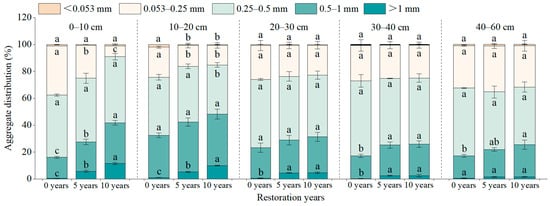
Figure 2.
Composition of soil aggregates at depths of 0–60 cm in different restoration years. Different lowercase letters indicate significant differences among different years of the same soil layer (p < 0.05).
3.2. Changes in Aggregate Stability at Different Restoration Years
The experimental results indicate that with an increase in restoration years, the MWD and GMD soils exhibited an upward trend across different soil layers (0–60 cm). Particularly in the 0–10 cm layer, the MWD significantly increased after 5 years and 10 years of restoration (p < 0.05), measuring 0.44 mm and 0.54 mm, respectively, and representing a 22.23% and 51.23% increase compared with 0 years. Similarly, the GMD significantly increased after 5 years and 10 years of restoration (p < 0.05), measuring 0.37 mm and 0.47 mm, respectively, representing a 24.16% and 59.34% increase compared with 0 years (Figure 3).
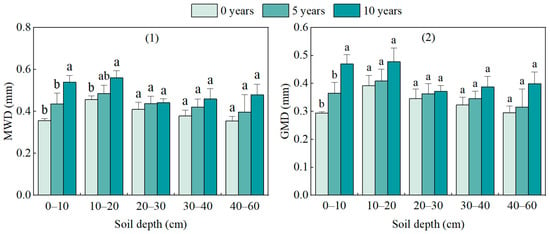
Figure 3.
The MWD (1) and GMD (2) of the aggregates at different restoration years. Different lowercase letters indicate significant differences among different years of the same soil layer (p < 0.05).
3.3. Changes in SOC and TN Contents and Density at Different Restoration Years
As seen in Figure 4, the contents and density of SOC and TN at different restoration years were in the order of 10 years > 5 years > 0 years, and gradually decreased with the increase in soil depth. In the 0–10 cm and 10–20 cm surface soils, compared with 0 years, the SOC at 10 years increased by 114.20% and 136.31%, respectively, and the TN content increased by 391.67% and 150.00%, respectively. In general, the content and density of SOC and TN increased significantly after ecological restoration (p < 0.05).
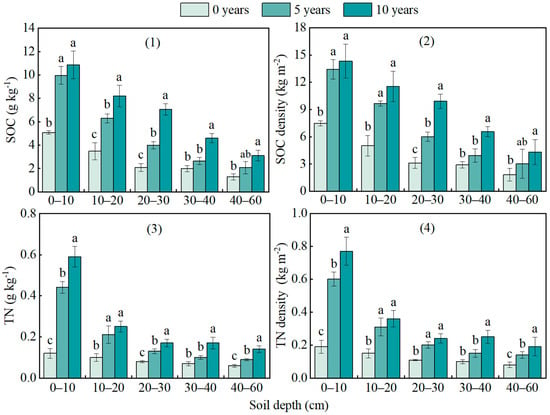
Figure 4.
The content and density of SOC (1), SOC density (2), TN content (3), and TN density (4), at different restoration years. Different lowercase letters indicate significant differences among different years of the same soil layer (p < 0.05).
3.4. Changes in Aggregates OC and N Contents and Density at Different Restoration Years
Figure 5 and Figure 6 illustrate that at different years of restoration periods, the OC and N of the aggregates were consistently ordered as 10 years > 5 years > 0 years. The contents of both elements gradually decreased as the soil depth increased. Compared with 0 years, the OC content in aggregates with a diameter >1 mm increased from 16.02% to 195.94% at 10 years, and from 4.69% to 126.01% at 5 years. Similarly, compared with 0 years, the TN in aggregates >1 mm in diameter saw an increase ranging from 100.00% to 366.67% at 10 years, and 66.67% to 300.00% at 5 years. In the 0–60 cm profile, the OC and N contents in all aggregate sizes declined as soil depth increased, reaching their highest concentrations at the 0–10 cm soil depth. After 5 years and 10 years of restoration, aggregates >1 mm in diameter exhibited a significant difference in OC and N contents at both the 0–10 cm and 10–20 cm soil layers (p < 0.05). At different durations, aggregates <0.053 mm in diameter possessed the highest OC content, followed by those exceeding 1 mm. Aggregates measured between 0.053 mm and 0.25 mm contained the least amount of OC. For all restoration years, aggregates <0.053 mm in diameter held the highest N content, with the least amounts found in aggregates >1 mm.
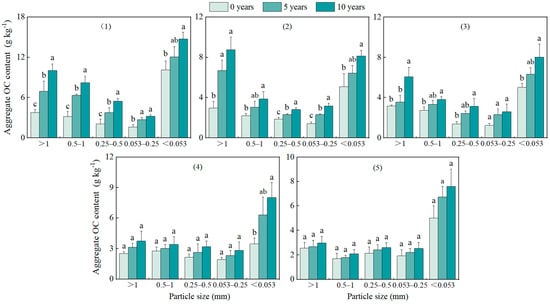
Figure 5.
Organic carbon content of the aggregates for 0–10 cm (1), 10–20 cm (2), 20–30 cm (3), 30–40 cm (4), and 40–60 cm (5) at different restoration years. Different lowercase letters indicate significant differences among different years of the same soil layer (p < 0.05).
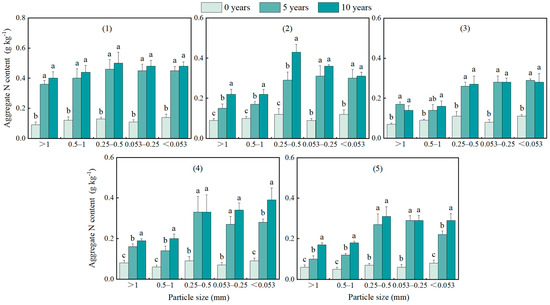
Figure 6.
Nitrogen content of the aggregates for 0–10 cm (1), 10–20 cm (2), 20–30 cm (3), 30–40 cm (4), and 40–60 cm (5) at different restoration years. Different lowercase letters indicate significant differences among different years of the same soil layer (p < 0.05).
3.5. Correlation Analysis
As evident from the correlation analysis results (Figure 7), there was a significant positive correlation (p < 0.05) between MWD, GMD, OC, and TN in the aggregates and OC, OCS, TN, TNS, SWC, silt, and clay in the soil. This relationship implies that the stability of the aggregates and the aggregates’ OC and TN contents during an ecological restoration process are closely related to the SOC and TN in the soil. Notably, the OC content in aggregates with a diameter >1 mm had an even stronger correlation with the SOC and TN content and density in the soil. This relationship indicates that changes in their levels can more sensitively reflect changes in the soil nutrients during the ecological restoration process.
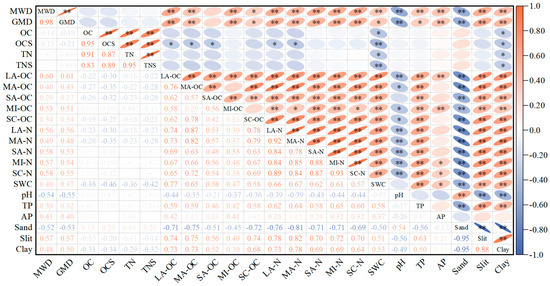
Figure 7.
Correlation analysis. MWD—mean weight diameter; GMD—geometric mean diameter; OC—soil organic carbon; OCS—soil organic carbon density; TN—total nitrogen; TNS—total nitrogen density; LA—large aggregate (>1 mm); MA—medium aggregate (0.5–1 mm); SA—small aggregate (0.25–0.5 mm); MI—microaggregate (0.053–0.25 mm); SC—silt + clay (<0.053 mm); SWC—soil water content; TP—total phosphorus; AP—available phosphorus. The values in the table are the Pearson correlation coefficients; * indicates significant correlation at the 5% level; ** indicates significant correlation at the 1% level.
4. Discussion
Soil aggregates, as the material basis of the soil structure and important carriers of soil fertility, directly affect the soil’s resistance to erosion, permeability, microhabitats, and carbon sequestration potential, and are key indicators of soil quality [4]. Aggregate stability is considered the foundation for the short-term accumulation and long-term stability of soil OM, typically evaluated according to MWD and GMD [12]. Generally, higher proportions of large (>0.25 mm) aggregate particles result in greater MWD and GMD values, indicating stronger aggregate stability and better soil structure [12]. Studies on desertified grasslands with different restoration durations have demonstrated that afforestation restoration in alpine desertified areas can enhance the content of macroaggregates (>0.25 mm), MWD, and GMD within the 0–60 cm soil layer, with the most pronounced improvement observed in surface soils, where 10 years of restoration showed superior effects compared with 5 years of restoration, indicating an overall improvement in aggregate composition. These findings align with Bai et al.’s research on aggregate stability in Masson pine forests in subtropical China [28]. This phenomenon occurs because Salix cupularis shrublands possess substantial biomass with dense litter layers, rapid root turnover, and abundant root exudates [29]. As the restoration duration increases, the vegetation coverage and biomass expand, the soil bulk density decreases, and the clay and silt contents rise, leading to improved soil structure, elevated organic matter and nutrient levels, and enhanced root and microbial activity. These changes further stimulate the formation of binding agents such as roots, hyphae, and decomposing microorganisms, collectively promoting macroaggregate formation and increasing the MWD and GMD values. For instance, arbuscular mycorrhizal fungi can physically entangle macroaggregates through hyphae and secrete polysaccharide-based cementing substances that bind microaggregates into stable macroaggregates [30]. Additionally, soil organic matter can form primary microaggregates with mineral particles through polyvalent cations (e.g., Ca2+, Fe3+, and Al3+), which subsequently combine with the surrounding particles to form macroaggregates [31].
This study found that during the 10-year restoration period, the recovery effects of macroaggregate content and MWD and GMD values in alpine desertified soils were not as significant as those in other degraded ecosystems. For instance, Su [31] reported increases of 3.83 mm and 2.88 mm in MWD and GMD, respectively, after afforestation restoration on the Loess Plateau, which were substantially higher than the restoration effects observed in this study’s alpine desertified area. This discrepancy may be attributed to desertification conditions and inherently weak soil integrity in the eastern Qinghai–Tibet Plateau region, coupled with the slow vegetation growth rates influenced by regional climatic characteristics, which collectively affect the afforestation restoration outcomes [32]. Furthermore, the increases in macroaggregate proportions and MWD and GMD values in deeper soil layers after 5 years and 10 years of restoration were markedly lower than in the surface soils, primarily due to the limited root extension range of Salix cupularis shrubs. Therefore, long-term restoration management through Salix cupularis planting in alpine desertified areas can effectively promote macroaggregate formation and enhance the aggregate stability, with particularly superior restoration effects in surface soils that facilitate water retention, nutrient enrichment, forage growth promotion, and ultimately, the rehabilitation of the soil structure in alpine desertified grasslands.
Key soil nutrients (such as carbon and nitrogen) primarily enter the soil through the decomposition of plant residues and root exudates, with their concentrations being crucial for evaluating the nutrient supply capacity and soil quality [33]. The soil nutrient content is also influenced by decomposition rates driven by soil microorganisms [34]. Soil aggregates of different particle sizes exhibit varying capacities for retaining and supplying carbon and nitrogen. Our results demonstrate that after afforestation restoration in alpine desertified soils, the OC and TN contents in aggregates of all sizes increased significantly, with the greatest increases observed in the >1 mm aggregates, followed by the 0.25–0.5 mm and 0.5–1 mm aggregates. Microaggregates maintained relatively stable carbon and nitrogen contents, consistent with the findings of Dou et al. [35]. This stability is attributed to the greater structural integrity and longer retention times of larger aggregates, which physically encapsulate organic matter to protect it from microbial activity and oxygen exposure, thereby reducing the C and N decomposition losses [12]. However, studies across different regions have reported varying distributions of organic carbon among aggregate fractions [36]. In our study, <0.053 mm aggregates showed the highest organic carbon content, likely due to the higher proportion of mineral-associated organic carbon in alpine meadow soils on the eastern Qinghai–Tibet Plateau [37], indicating greater quantities of recalcitrant organic carbon in this region. Furthermore, we found significant positive correlations between aggregate carbon, nitrogen content, and macroaggregate proportion, aggregate stability (MWD and GMD), and the soil clay and silt content. Enhanced soil stability, macroaggregate content, silt, and clay fractions all contributed significantly to improved aggregate carbon and nitrogen sequestration. Therefore, when assessing afforestation restoration effects in alpine desertified areas of the eastern Qinghai–Tibet Plateau, special attention should be paid to changes in the aggregate structure to more accurately evaluate the ecological restoration outcomes in these fragile ecosystems.
5. Conclusions
This study revealed that the restoration of a 0–60 cm alpine desert grassland in the Zoige Plateau significantly increased the proportion of large aggregates in the surface soil (0–20 cm) and improved the stability of the aggregates, with the most pronounced changes observed in the 0–10 cm soil layer. Both reforestation and recovery periods significantly boosted the increase in OC and TN in the topsoil (0–20 cm), with the largest increase witnessed in the 0–10 cm soil layer. During the 10-year and 5-year restoration periods, the OC and TN contents found in the soil aggregates of various diameters in the 0–10 cm layer all significantly increased. Aggregates with diameters >1 mm showed the highest increase in OC and TN, whereas aggregates <0.053 mm had a relatively small growth rate of OC and TN. Compared with 5 years, 10 years was more advantageous in promoting the formation of larger aggregates, enhancing the aggregate stability, and accumulating OC and TN. Therefore, planting Salix cupularis is conducive to the soil structure of sandy grasslands on the eastern edge of the Qinghai–Tibet Plateau and increasing the nutrient content of carbon and nitrogen. This study evaluated variations in the soil aggregate properties and stability, along with the SOC and TN levels across different vegetation restoration years in the sandy grasslands of the Zoige Plateau, providing basic data and a theoretical basis for desertification control in alpine regions.
Author Contributions
Conceptualization, W.H., H.Q. and Y.H.; Methodology, W.H. and H.Q.; Software, W.H. and H.Q.; Validation, W.H., H.Q. and Y.H.; Formal analysis, W.H. and H.Q.; Investigation, H.Q. and H.J.; Resources, Y.H.; Data curation, H.Q. and Y.H.; Writing—original draft preparation, W.H., H.Q. and X.G.; Writing—review and editing, W.H., H.Q. and H.J.; Visualization, W.H. and H.Q.; Supervision, Y.H.; Project administration, H.Q. and Y.H.; Funding acquisition, Y.H. All authors have read and agreed to the published version of the manuscript.
Funding
This research was funded by the National Natural Science Foundation of China (No. 41771552) and the Sichuan Science and Technology Project (No. 2022YFS0469).
Data Availability Statement
The original contributions presented in this study are included in the article. Further inquiries can be directed to the corresponding author.
Acknowledgments
The authors thank the reviewers and editor for their insightful comments and constructive suggestions.
Conflicts of Interest
The authors declare no conflicts of interest.
References
- Sullivan, P.L.; Billings, S.A.; Hirmas, D.; Li, L.; Zhang, X.; Ziegler, S.; Murenbeeld, K.; Ajami, H.; Guthrie, A.; Singha, K.; et al. Embracing the dynamic nature of soil structure: A paradigm illuminating the role of life in critical zones of the Anthropocene. Earth-Sci. Rev. 2022, 225, 103873. [Google Scholar] [CrossRef]
- Han, C.; Song, M.X.; Tang, Q.L.; Wei, J.; He, X.B.; Collins, A.L. Post-farming land restoration schemes exhibit higher soil aggregate stability and organic carbon: Evidence in the Three Gorges Reservoir Area, China. Catena 2023, 227, 107099. [Google Scholar] [CrossRef]
- Deng, L.; Kim, D.G.; Peng, C.; Shangguan, Z. Controls of soil and aggregate associated organic carbon variations following natural vegetation restoration on the Loess Plateau in China. Land Degrad. Dev. 2018, 29, 3974–3984. [Google Scholar] [CrossRef]
- Tisdall, J.M.; Oades, J.M. Organic matter and water-stable aggregates in soils. Eur. J. Soil Sci. 1982, 33, 141–163. [Google Scholar] [CrossRef]
- Jia, L.; Yu, K.X.; Li, Z.B.; Li, P.; Zhang, A.N.; Ma, L.; Xu, G.C.; Zhang, X. Temporal and spatial variation of rainfall erosivity in the Loess Plateau of China and its impact on sediment load. Catena 2022, 210, 105931. [Google Scholar] [CrossRef]
- Zhu, G.Y.; Shangguan, Z.P.; Deng, L. Soil aggregate stability and aggregate-associated carbon and nitrogen in natural restoration grassland and Chinese red pine plantation on the Loess Plateau. Catena 2017, 149, 253–260. [Google Scholar] [CrossRef]
- Deng, L.; Peng, C.H.; Kim, D.G.; Li, J.W.; Liu, Y.L.; Hai, X.Y.; Huang, C.B.; Shangguan, Z.P.; Kuzyakov, Y. Drought effects on soil carbon and nitrogen dynamics in global natural ecosystems. Earth-Sci. Rev. 2021, 214, 103501. [Google Scholar] [CrossRef]
- Garcia-Franco, N.; Wiesmeier, M.; Buness, V.; Berauer, B.J.; Schuchardt, M.A.; Jentsch, A.; Schlingmann, M.; Andrade-Linares, D.; Wolf, B.; Kiese, R.; et al. Rapid loss of organic carbon and soil structure in mountainous grassland topsoils induced by simulated climate change. Geoderma 2024, 442, 116807. [Google Scholar] [CrossRef]
- Leinweber, P.; Jandl, G.; Baum, C.; Eckhardt, K.U.; Kandeler, E. Stability and composition of soil organic matter control respiration and soil enzyme activities. Soil Biol. Biochem. 2008, 40, 1496–1505. [Google Scholar] [CrossRef]
- Liu, J.J.; Liu, J.Y.; Wang, S.W.; Fu, Q.; Baoyin, T.; Bao, Z.H.; Li, F.Y. Soil biological nitrogen fixation is closely associated with soil ammonium nitrogen content in a mowing semiarid natural grassland. Appl. Soil Ecol. 2024, 203, 105690. [Google Scholar] [CrossRef]
- Bahur, E.; Kara, O.; Fathi, R.A.; Susam, Y.E.; Riza, M.; Arif, M.; Akhtar, K. Wattle fencing improved soil aggregate stability, organic carbon stocks and biochemical quality by restoring highly eroded mountain region soil. J. Environ. Manag. 2021, 288, 112489. [Google Scholar] [CrossRef]
- Adnan, M.; Xu, M.G.; Syed, A.A.S.; Muhammad, M.A.; Sun, N.; Wang, B.R.; Cai, Z.J.; Qudsia, S.; Muhammad, N.; Khalid, M.; et al. Soil aggregation and soil aggregate stability regulate organic carbon and nitrogen storage in a red soil of southern China. J. Environ. Manag. 2020, 270, 110894. [Google Scholar] [CrossRef]
- Kou, T.J.; Zhu, P.; Huang, S.; Song, Z.W.; Deng, A.X.; Gao, H.J.; Peng, C.; Zhang, W.J. Effects of long-term cropping regimes on soil carbon sequestration and aggregate composition in rainfed farmland of Northeast China. Soil Till. Res. 2012, 118, 132–138. [Google Scholar] [CrossRef]
- Tiessen, H.; Cuevas, E.; Chacon, P. The role of soil organic matter in sustaining soil fertility. Nature 1994, 371, 783–785. [Google Scholar] [CrossRef]
- Zhou, H.L.; Qu, Q.; Xu, H.W.; Wang, M.G.; Xue, S. Effects of vegetation restoration on soil microbial necromass carbon and organic carbon in grazed and degraded sandy land. J. Environ. Manag. 2025, 382, 125380. [Google Scholar] [CrossRef]
- Qiu, L.P.; Wei, X.R.; Gao, J.L.; Zhang, X.C. Dynamics of soil aggregate-associated organic carbon along an afforestation chronosequence. Plant Soil 2015, 391, 237–251. [Google Scholar] [CrossRef]
- Wang, D.Y.; Fonte, S.J.; Parikh, S.J.; Six, J.; Scow, K.M. Biochar additions can enhance soil structure and the physical stabilization of C in aggregates. Geoderma 2017, 303, 110–117. [Google Scholar] [CrossRef]
- Zhao, F.Z.; Ren, C.J.; Han, X.H.; Yang, G.H.; Wang, J.; Doughty, R. Changes of soil microbial and enzyme activities are linked to soil C, N and P stoichiometry in afforested ecosystems. For. Ecol. Manag. 2018, 427, 289–295. [Google Scholar] [CrossRef]
- Jiang, X.; Li, H.; Qu, Y.P.; Jian, B.H.; Deng, D.Z.; Liu, M.; Yang, J.T.; Chen, D.C.; Huang, Y. Effects of grazing exclusion on vegetation community characteristics over 22 years in the Zoige alpine meadows from China. Acta Oecol. 2023, 118, 103892. [Google Scholar] [CrossRef]
- Wu, X.W.; Wang, Y.C.; Sun, S.C. Long-term fencing decreases plant diversity and soil organic carbon concentration of the Zoige alpine meadows on the eastern Tibetan Plateau. Plant Soil 2021, 458, 191–200. [Google Scholar] [CrossRef]
- Li, Q.; Shen, X.; Huang, Q.; Sun, F.; Zhou, J.; Ma, X.; Ran, Z.; Chen, Y.; Li, Z.; Yan, Y.; et al. Resource islands of Salix cupularis facilitating seedling emergence of the companion herbs in the restoration process of desertified alpine meadow, the Tibetan Plateau. J. Environ. Manag. 2021, 289, 112434. [Google Scholar] [CrossRef] [PubMed]
- Du, C.J.; Jing, J.; Shen, Y.; Liu, H.X.; Gao, Y.H. Short-term grazing exclusion improved topsoil conditions and plant characteristics in degraded alpine grasslands. Ecol. Indic. 2020, 108, 105680. [Google Scholar] [CrossRef]
- Wang, Z.; Li, X.L.; Ji, B.M.; Struik, P.C.; Jin, K.; Tang, S.M. Coupling between the responses of plants, soil, and microorganisms following grazing exclusion in an overgrazed grassland. Front. Plant Sci. 2021, 12, 640789. [Google Scholar] [CrossRef] [PubMed]
- Jiang, X.; Qu, Y.; Zeng, H.; Yang, J.; Liu, L.; Deng, D.; Ma, Y.; Chen, D.; Jian, B.; Guan, L.; et al. Long-term ecological restoration increased plant diversity and soil total phosphorus content of the alpine flowing sand land in northwest Sichuan, China. Heliyon 2024, 10, e24035. [Google Scholar] [CrossRef]
- FAO. Guidelines for Soil Description, 4th ed.; Food and Agriculture Organization of the United Nations: Rome, Italy, 2006. [Google Scholar]
- Lu, R.K. Soil Agrochemical Analysis Methods; China Agricultural Science and Technology Press: Beijing, China, 2000. [Google Scholar]
- Elliott, E. Aggregate structure and carbon, nitrogen, and phosphorus in native and cultivated soils. Soil Sci. Soc. Am. J. 1986, 50, 627–633. [Google Scholar] [CrossRef]
- Bai, Y.; Zhou, Y.; He, H. Effects of rehabilitation through afforestation on soil aggregate stability and aggregate-associated carbon after forest fires in subtropical China. Geoderma 2020, 376, 114548. [Google Scholar] [CrossRef]
- Wu, Y.C.; Li, Z.C.; Cheng, C.F.; Liu, R.J.; Wang, B.; Ge, R.L.T. Effects of understory removal on soil labile organic carbon pool in a Cinnamomum camphora plantation. Chin. J. Appl. Ecol. 2013, 24, 3341–3346. [Google Scholar] [CrossRef]
- Han, Z.G.; Zhou, Y.C.; Ren, J.J. Effects of organic matter-bound multivalent cations on the internal and external formation of soil aggregates under Pinus massoniana forest. J. Soil Water Conserv. 2021, 76, 568–576. [Google Scholar] [CrossRef]
- Su, Z.X.; Zhu, S.; Wei, Z.H.; He, Y.X.; Su, B.Q.; Zhang, K.; Ma, X.; Shangguan, Z.P. Vegetation restoration changed the soil aggregate stability and aggregate carbon stabilization pathway according to δ13C signatures. Agric. Ecosyst. Environ. 2025, 378, 109317. [Google Scholar] [CrossRef]
- Shu, X.Y.; Hu, Y.H.; Liu, W.J.; Xia, L.; Zhang, Y.Y.; Zhou, W.; Liu, W.L.; Zhang, Y.L. Linking between soil properties, bacterial communities, enzyme activities, and soil organic carbon mineralization under ecological restoration in an alpine degraded grassland. Front. Microbiol. 2023, 14, 1131836. [Google Scholar] [CrossRef]
- Bing, H.J.; Wu, Y.H.; Zhou, J.; Sun, H.Y.; Luo, J.; Wang, J.P.; Yu, D. Stoichiometric variation of carbon, nitrogen, and phosphorus in soils and its implication for nutrient limitation in alpine ecosystem of Eastern Tibetan Plateau. J. Soil Sediment 2016, 16, 405–416. [Google Scholar] [CrossRef]
- Shi, J.W.; Deng, L.; Yang, L.; Dong, Y.J.; Liao, Y.; Li, J.W.; Liu, Y.R.; Ren, C.J.; Yang, F.; Shangguan, Z.P.; et al. Deciphering microbial divers of soil organic matter mineralization in surface and subsurface soil during long-term vegetation succession. Agric. Ecosyst. Environ. 2024, 374, 109186. [Google Scholar] [CrossRef]
- Dou, X.; Xu, X.; Shu, X.; Zhang, Q.; Cheng, X. Shifts in soil organic carbon and nitrogen dynamics for afforestation in central China. Ecol. Eng. 2016, 87, 263–270. [Google Scholar] [CrossRef]
- Lu, L.X.; Song, T.Q.; Peng, W.X.; Zeng, F.P.; Wang, K.L.; Xu, Y.L.; Yu, Z.; Liu, Y. Profile distribution of soil aggregates organic carbon in primary forests in Karst cluster-peak depression region. Chin. J. Appl. Ecol. 2012, 23, 1167–1174. [Google Scholar] [CrossRef]
- Zheng, J.J.; Fang, H.J.; Cheng, S.L.; Yu, G.R.; Zhang, P.L.; Xu, M.J.; Li, Y.N. Effects of N addition on soil organic carbon components in an alpine meadow on the eastern Qinghai-Tibetan Plateau. Acta Ecol. Sin. 2012, 32, 5363–5372. [Google Scholar] [CrossRef]
Disclaimer/Publisher’s Note: The statements, opinions and data contained in all publications are solely those of the individual author(s) and contributor(s) and not of MDPI and/or the editor(s). MDPI and/or the editor(s) disclaim responsibility for any injury to people or property resulting from any ideas, methods, instructions or products referred to in the content. |
© 2025 by the authors. Licensee MDPI, Basel, Switzerland. This article is an open access article distributed under the terms and conditions of the Creative Commons Attribution (CC BY) license (https://creativecommons.org/licenses/by/4.0/).